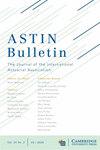FUNCTIONAL PROFILE TECHNIQUES FOR CLAIMS RESERVING
IF 1.8
3区 经济学
Q2 ECONOMICS
引用次数: 1
Abstract
Abstract One of the most fundamental tasks in non-life insurance, done on regular basis, is risk reserving assessment analysis, which amounts to predict stochastically the overall loss reserves to cover possible claims. The most common reserving methods are based on different parametric approaches using aggregated data structured in the run-off triangles. In this paper, we propose a rather non-parametric approach, which handles the underlying loss development triangles as functional profiles and predicts the claim reserve distribution through permutation bootstrap. Three competitive functional-based reserving techniques, each with slightly different scope, are presented; their theoretical and practical advantages – in particular, effortless implementation, robustness against outliers, and wide-range applicability – are discussed. Theoretical justifications of the methods are derived as well. An evaluation of the empirical performance of the designed methods and a full-scale comparison with standard (parametric) reserving techniques are carried on several hundreds of real run-off triangles against the known real loss outcomes. An important objective of the paper is also to promote the idea of natural usefulness of the functional reserving methods among the reserving practitioners.用于索赔保留的功能概要文件技术
风险准备评估分析是非寿险保险中最基本的任务之一,它是随机预测承保可能的索赔的总体损失准备。最常见的保留方法是基于不同的参数方法,使用径流三角形中结构化的聚合数据。本文提出了一种非参数化方法,该方法将潜在损失发展三角形作为函数剖面处理,并通过排列自举法预测索赔储备分布。提出了三种竞争性的基于功能的保留技术,每种保留技术的范围略有不同;讨论了它们在理论和实践上的优点,特别是易于实现、对异常值的鲁棒性和广泛的适用性。并对方法进行了理论论证。对所设计方法的经验性能进行了评估,并与标准(参数)保留技术进行了全面比较,针对数百个实际径流三角形的已知实际损失结果。本文的一个重要目的是在保留从业者中推广功能保留方法的自然有用性理念。
本文章由计算机程序翻译,如有差异,请以英文原文为准。
求助全文
约1分钟内获得全文
求助全文
来源期刊

ASTIN Bulletin
数学-数学跨学科应用
CiteScore
3.20
自引率
5.30%
发文量
24
审稿时长
>12 weeks
期刊介绍:
ASTIN Bulletin publishes papers that are relevant to any branch of actuarial science and insurance mathematics. Its papers are quantitative and scientific in nature, and draw on theory and methods developed in any branch of the mathematical sciences including actuarial mathematics, statistics, probability, financial mathematics and econometrics.
 求助内容:
求助内容: 应助结果提醒方式:
应助结果提醒方式:


